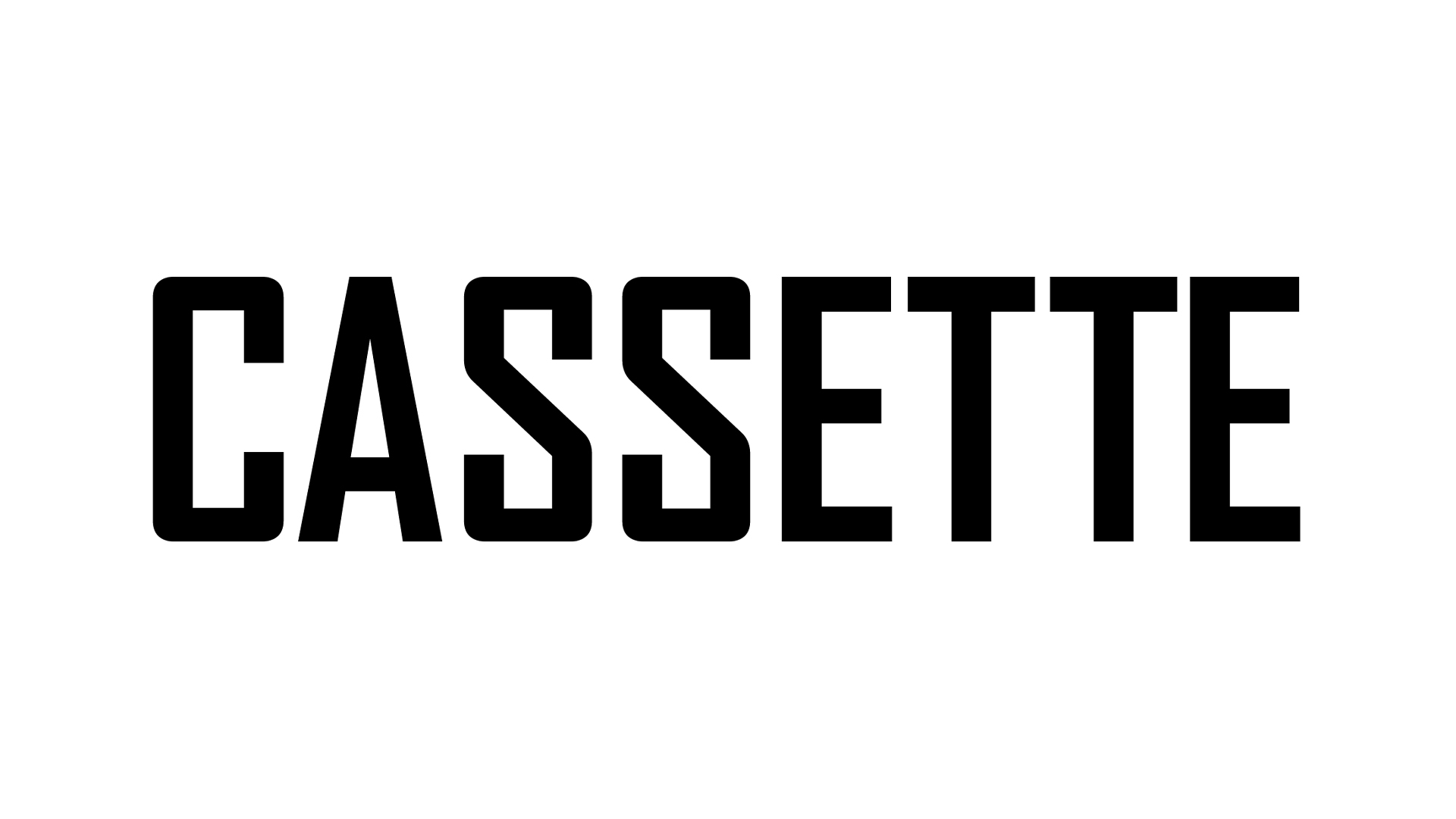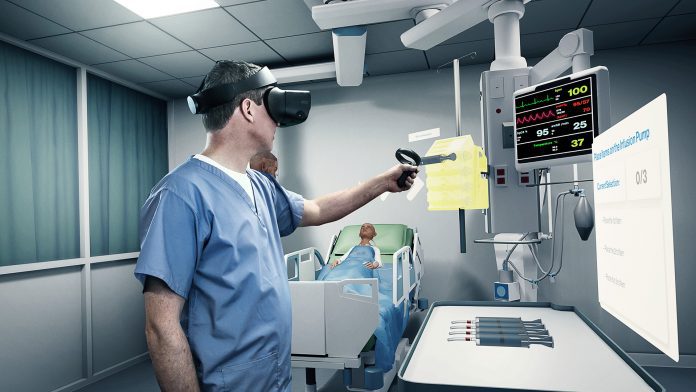
Immersive technology specialist Cassette explains how VR, AR, and immersive web solutions are transforming healthcare education.
Immersive technologies, adopted from the gaming industry, are going to transform the quality and availability of training and communication across the healthcare industry.
Technologies often seen as gimmicks, such as virtual reality and 3D ‘games’, are now maturing to a stage where they are viable solutions to industry and business challenges, not only improving engagement but delivering better results at a lower cost.
Virtual Reality (VR) in particular has been used for some time, more notably in the surgical space. However, on the whole, the price of hardware and general accessibility of these training tools has limited mass adoption.
As hardware rapidly improves and drops in price, alongside new technologies and infrastructure coming to market, the business case for immersive technology solutions more than makes sense.
The challenge(s)
It is well documented that healthcare professionals are lacking in time. Not only does this mean there is limited time to put towards training, but any time actually spent learning is generally done so under pressure, resulting in low retention rates.
Additionally, with healthcare becoming more and more complex, traditional rote learning is no longer as effective. Text-heavy, dense training materials are difficult to digest and comprehend out of context.
As such, there is a general move towards simulation-based learning. However, this comes with its own challenges. Simulation training has to be carried out face-to-face, generally requiring expensive machinery, manikins, space, and personnel. There is no doubt that this is the optimal form of learning, but time, cost, and location mean it is both difficult to deliver and to attend on a regular basis. Throw in a global pandemic and time and resources become even harder to come by, precisely when speed and scale of training are needed most.
All these pressures contribute towards an overall dissatisfaction in the training available and subsequent opportunities for career progression. The NHS long term plan identifies that many of those leaving the NHS would remain if they were offered improved development opportunities and more control over their working lives.
Immersive technology solutions
Immersive technologies are a tool set that can go a long way to tackling the challenges faced with training and education. They are never going to be the whole solution, but they can make a big impact on the accessibility, scale, quality, and cost of training content, allowing face-to-face time to become more productive and effective.
What are immersive technologies?
Immersive technologies stem from the gaming industry. This technology is referred to as ‘real time’ and involves the creation of 3D immersive environments that a ‘player’ can navigate and interact with. How that user interacts or navigates depends on the intended platform. For example, in gaming, many will have heard of the popular game Fortnite. This is generally played using a games console and a controller. For training and education, the platforms typically include virtual reality, augmented reality, and immersive web. The definitions are below.
Virtual Reality
Definition: The user wears a Virtual Reality headset and is immersed within a 3D virtual environment. For example, a hospital ward or intensive care unit (ICU). The user has freedom to walk about the virtual space and use the controllers to pick up and interact with machinery.
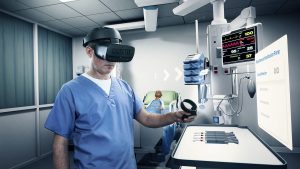
Immersive web
Definition: Users access the content on their desktop or mobile device via a URL. Users can navigate through 3D environments with keyboard controls similar to a computer game. Users interact with the environment and machinery using traditional website navigation.
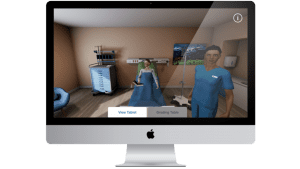
Augmented Reality
Definition: Technology that superimposes a computer-generated image on a user’s view of the world. In other words, using a mobile device or a specialised headset 3D objects appear within the ‘real’ world.
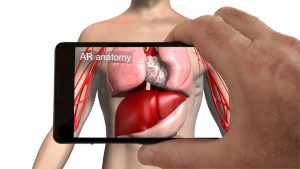
Considerations
To deliver effective education and training solutions that make business sense, it is important to consider both who the end user is as well as how and where the content will be used.
For example, incredible content could be created for a games console like the Xbox, however the hardware requirement means costs are high and the opportunity for scale and distribution is minimal.
Alternatively intricate, simulated training content can be developed and distributed via Virtual Reality headsets. Cost of hardware has reduced significantly over the last three years, making Virtual Reality a really viable solution.
However, content creators must be mindful of the end users who are healthcare professionals, not avid gamers. We therefore need to pay particular attention to creating experiences that are intuitive and simple to use. The training should test the user on their knowledge of the target subject, not how well they can operate a VR headset.
In other cases, scale and volume are key. Distribution of large numbers of VR headsets may not be viable and an immersive web solution is most suitable. Whilst not as immersive as Virtual Reality, immersive web still allows for interaction and engagement but via any device that can connect to the internet.
As with anything, it is not a ‘one-size-fits-all’ solution. However, there are a range of platforms that offer a compelling business case for immersive training, depending on the goals and target user base.
Done right, immersive technologies offer the power of simulation training delivered at the scale and cost of traditional online learning.
Use cases
In general, immersive technologies are best used in training and education when there is an intricate, complicated topic to be communicated. Typically, any content that would work well simulated face-to-face is suitable for this platform.
The learning pyramid model, developed by the National Training Laboratory, suggests that people remember 10% of what they read, 20% of what they watch, and 75% of what they do. This is why getting users to perform actions and ‘do’ is really important, developing muscle memory as well as offering visual and audio reference points.
Great examples for immersive technology training include:
Operating machinery
Medical machinery is expensive and in high demand. Freeing up time for training is costly and takes up valuable capacity for patients. It is now possible to create a ‘digital twin’ of medical devices, offering a digital replica that can be used any time over web, or via VR headsets. Whether it is for operating an MRI, dialysis machine or any number of other medical scenarios, training virtually offers a safe environment for the user to fail and learn, ensuring any face-to-face training has a higher impact.
The benefits of creating a ‘digital twin’ extend beyond just training, through to sales and marketing, and even R&D and technical support. The practice has been adopted successfully in other industries and has the potential to make a significant impact in healthcare.

Clinical deterioration in patients
Virtual Reality or immersive web can be used to recreate scenarios in which patients are clinically deteriorating over time. Users are presented with clinical data and symptoms and asked to make decisions and perform actions accordingly. For example, for a patient experiencing sepsis.
At Cassette, we have developed a training platform, known as Pathway, for recreating patient deterioration. Pathway outputs content to both Virtual Reality and immersive web and has recently been used for delivering a training experience to educate healthcare professionals on the suitable actions to take with patients post-CAR-T therapy, an innovative cancer treatment.
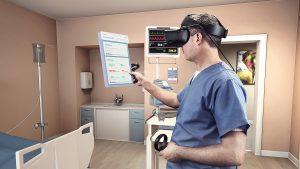
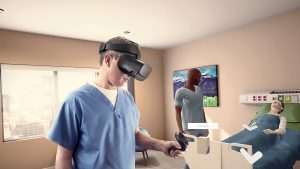
The opportunities are vast, other great use cases include:
- Replicating emergency scenarios
- Learning procedures
- Performing surgery
- Patient roleplaying
Benefits
The benefits of immersive technology solutions can be measured on a case-by-case basis but, importantly, they can be easily tracked.
Data capture
As with many digital solutions, we can track usage, completion, and performance, however there is opportunity to go further.
Understanding exactly how users interact with an experience, where they fail, and where they succeed allows for in-depth analysis, constant improvement to training materials, and personalised feedback to the users.
Cost
Immersive technologies provide the opportunity to reduce costs and training budgets without jeopardising the quality of content. Costs per head and quality of content vary according to the chosen platform – Virtual Reality, Augmented Reality, immersive web – but all compare favourably to traditional training.
In particular, PWC has noted a growing body of evidence to the value and effectiveness of virtual training, stating that “virtual training is the most cost-effective way of learning when it is done on a large scale. At 3,000 learners, VR costs become 52% less than classroom.”
Always on / accessibility
Another benefit is that that immersive technology enables flexible and accessible training for all, whenever and wherever needed.
A report by XR Health commented that: “Many XR technologies remove the temporal and geographical barriers to training. This enables healthcare professionals to learn in their own time, at their own pace and unconstrained by physical locations such as the hospital. In addition, they facilitate the dissemination of knowledge and skills from centres of excellence, ensuring democratisation and accessibility in training across the NHS. These technologies also provide a unique opportunity for replication of dangerous, difficult, and inconvenient locations. This has the potential to improve accessibility, reduce inequalities in training and improve patient safety.”
Speed and distribution possibilities
Immersive web solutions offer full scale and accessibility while AR and VR offer full immersion where headsets and hardware are available. We now have the option to deliver simulated, immersive content, at scale and speed across multiple platforms.
Additionally, as content continues to update and change in line with policy, the same experiences can be updated centrally, ensuring rapid rollout.
The future
This technology is developing rapidly. Only a few years ago, Virtual Reality required expensive PCs and peripheral equipment, compared to today where headsets are standalone and cost in the region of £400.
Hardware is only getting better and more cost effective. Augmented Reality headsets, can be as expensive as $3,500 and over. However, with new players coming into the market, including Apple and Facebook, it is likely that solutions will quickly become more affordable.
Reduced prices and more hardware options will open up more use cases for these technologies.
Finally, the rollout of 5G technology will have a significant impact in this space. As processing power moves from the user’s device to the Cloud, we will be able to deliver richer, more interactive, and more immersive experiences across all devices.


